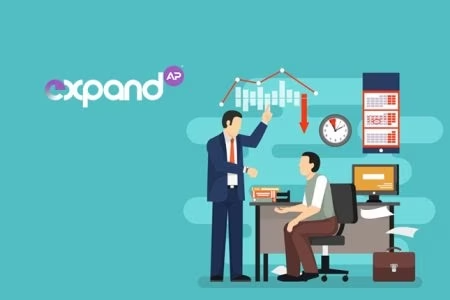Make Your Salesforce accounts payable management fast, accurate, and easy.
press
See the events where you can meet the ExpandAP team, get details about our impact on the industry and explore company news and insights.
Digital transformation’s fundamental change management mistake

Too often change management is treated as a post-DX add-on. Instead, drive change preemptively by injecting user-centric change practices into your digital development and delivery workflows.
Unfortunately, the business impact of many digital transformations continues to fall short of expectations.
For example, KPMG reports that 51% of technology executives have not seen an increase in performance or profitability from digital transformation investments. HBR’s “The Value of Digital Transformation” reports, “While 89% of large companies globally have a digital and AI transformation underway, they have only captured 31% of the expected revenue lift and 25% of expected cost savings from the effort.”
Ask CIOs about their biggest digital transformation challenges, and they’re likely to cite people issues or what experts identify as gaps in change management practices. When CIOs can’t drive change, new digital products and technology capabilities can become shelfware, and the business value is delayed or diminished.
Martin Davis, CIO and managing partner at Dunelm Associates, says not to declare success too early: “Too many projects prematurely declare success at the point of process or system implementation and fail to recognize that change management efforts must continue for some time after implementation to realize the full value.”
Orchestrating change
Change management in digital transformation initiatives includes engaging stakeholders in planning, easing adoption with employees, and improving experiences for customers and all those involved in the program.
At the start of any transformation initiative, there’s a dip in momentum during the planning phase when executives must be convinced to invest in digital transformation and business stakeholders must be worked with to develop a prioritized roadmap. Organizations with long, complex, and expensive upfront planning processes due to executive and stakeholder alignment issues can result in missed opportunities if competitors bring capabilities to market faster.
But the bigger challenge is often downstream and occurs when digital trailblazers, the people assigned to lead digital transformation initiatives, must work with end-users on process changes and technology adoption. When devops teams release changes to applications, dashboards, and other technology capabilities, end-users experience a productivity dip before people effectively leverage new capabilities. This dip delays when the business can start realizing the value delivered.
While there are a number of change management frameworks and certifications, many treat change as separate disciplines from the product management, agile, and devops methodologies CIOs use to plan and deliver digital transformation initiatives. That’s a problem because the mismatch in terminology, philosophies, and responsibilities can lead to process gaps or worse, process wars between different leaders driving incompatible methodologies.
Joanne Friedman, PhD, CEO, and principal of smart manufacturing at Connektedminds, says orchestrating success in digital transformation requires a symphony of integration across disciplines: “CIOs face the challenge of harmonizing diverse disciplines like design thinking, product management, agile methodologies, and data science experimentation. It’s like trying to get a jazz quartet, a rock band, a classical orchestra, and a DJ to play in harmony.”
Reducing productivity dips and easing end-user adoption then are practices that must fit the digital and transformation operating model. Let’s consider three areas where CIOs and digital trailblazers can inject change management into their digital transformation initiatives in a way that brings greater effectiveness than if change management were addressed as a separate add-on.
Product managers must start with why
There’s a good reason bestselling author Simon Sinek advises great leaders to start with why.
“When collaborating with peers, focus on the why and not the what,” says John Milburn, CEO of Clear Skye. “While the CIO sees the big picture, their peers need to know how the change will benefit them.”
While CIOs must take steps to ensure their peers understand the importance of digital transformation initiatives, they must rely on their digital trailblazers to do the same with their stakeholders and teams.
We’re asking employees to implement many changes and to continuously improve results. Employees see this as added work and stress unless they understand an initiative’s importance, where it will deliver business value, and why they should care. Janette Gleyzer, transformation advisor and coach at StarCIO, says digital trailblazers should address the why by answering reflective questions such as what defines success and what patterns emerged from past failures.
The top of the funnel for change management in digital transformations is the responsibility of the product manager or the program manager in some organizations. They must start the process by communicating a simple-to-understand vision statement that defines the targeted customers, value proposition, and strategic importance.
Large organizations will go beyond ideation workflows, vision statement writing, and developing roadmaps to value stream mapping to help connect strategy with execution, delivery, and change management. Value stream mapping can be an important tool to help illustrate to employees the value of their work.
“Savvy digital transformation leaders will rely on value stream mapping to familiarize each decision-maker and stakeholder with how the technology works every step of the way, demonstrating a clear vision of what it can do for the business and the individual,” says Paul Wnek, founder and CEO of ExpandAP. “A digital trailblazer’s best chance for success happens when they consider all the stakeholders they will touch and approach each stakeholder’s concerns separately.”
Agile teams must commit to change management during sprints
Change management isn’t just the product manager’s responsibility. They should set expectations for their agile teams on simplifying end-user adoption.
Agile and scrum methodologies put most of the emphasis on delivery activities when teams focus on completing user stories every sprint. Product owners and scrum masters must also engage the team in planning activities, including writing user stories, estimating work, and grooming backlogs.
John Ottman, executive chairman of Solix Technologies, says, “Beyond driving the cadence, orchestration, and ceremony of the scrum, the scrum master needs to work closely with product owners to validate that the epics, users stories, and tasks are all clear and properly documented such that the expected outcomes meet the expectations of each sprint.”
Documentation and well-written user stories guide teams in completing the work and meeting requirements. They can also be used in change management activities when product owners share the requirements with stakeholders, subject matter experts, and employees participating in user acceptance testing.
Showing end-users all the details in a user story can be overwhelming, so agile teams should look to simplify them to support change management activities. Tools such as Atlassian Confluence can pull sections of user stories from Jira Software so that product owners can simplify the presentation. Another option is to use a generative AI tool to summarize the user stories completed in a sprint and to aid in writing release notes. The best option is when the product team reviews requirements in open sprint review sessions, inviting key stakeholders and end-users to attend.
Taking this one step further, I like to see agile teams take on change management activities as another form of work they commit to every sprint. This should include participating in training activities, interviewing end-users, reviewing performance metrics, and capturing other forms of feedback they can use to improve their work.
Devops must not undermine change management
How often should agile teams release code into production?
Many teams adopting devops best practices have automated their deployment pipelines with CI/CD, implemented continuous testing, and are confident in their security and operations to implement continuous deployment.
The automation improves quality and reduces toil, but frequent deployments may not be ideal for end-users and can burden change management activities. Devops teams must consider the impact on end-users, and they have several options to reduce affecting end-users with too many changes.
Below are four devops recommendations for increasing deployment frequency without complicating change management and negatively impacting end-users.
- Automate continuous deployment for only small fixes and minor changes that have a low impact on end-users and minimal change management requirements.
- Instill a more controlled release management process when deployments change workflow, user interfaces, and new capabilities.
- Create feature flags and decide which users can provide early feedback on a new capability before rolling it out to more people.
- Leverage canary releases and control rolling out new capabilities to small user segments.
Ottman adds, “By implementing new features to a selected, small part of the users first so they may test it and provide feedback, assurance may be gained that once the change is accepted, the update will be successful for the entire user base.”
Change management practices are integral to delivering business results from digital transformation initiatives. To ease adoption, CIOs and digital trailblazers should look to fit change management practices into their digital operating models so that end-users learn, experience, and adopt changes through all phases of the journey.
- Tags: accounting, accounting positions, accounting programs, accounts payable, accouting shortage, accouting teams, AI, analytics capablities, artificial general intelligence, automation, data entry, financial, financial leaders, labor stats, resource gap, technology
Schedule a free demo today.
We’re eager to show you more about how ExpandAP saves time and resources for your organization. Book a demo and see how you can streamline expense management and accounts payable processes.





